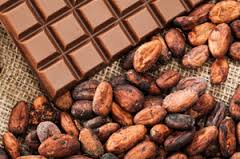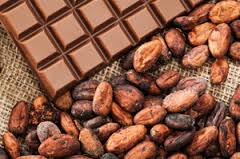
Due to an abundant supply and weakening demand as growing health consciousness grips consumers, cocoa prices are in a meltdown, hitting a four-year low.
In an extended year-long decline after 2015's weather-related rally, the lowest level since March 2013 was hit by the benchmark cocoa futures on the Intercontinental Exchange in New York which clocked $2,052 per metric ton on February 3.
Weighing down prices is a bumper crop last season from benign weather in West Africa. Accounting for more than two-thirds of global supply, Ivory Coast and Ghana are the world's top producers of cocoa beans.
"The Harmattan season—marked by dry and dusty winds blowing from the Sahara—has been weak this season, and has so far not created much damage to cocoa crops," said Singapore-based Phillip Futures soft commodities dealer, Wilfred Chong. "Instead, weather conditions are seen to be improving, fuelling the selloff."
Pegging support at $2,000 a ton, Chong said that ICE cocoa may fall further.
Reuters reported in January that as exporters who put in bids for the commodity at high prices are now stuck with stock they're unwilling to sell at a loss in the largest cocoa producing country of Ivory Coast, beans are piling up at warehouses and ports.
As weight-conscious consumers are cutting down on snacking, demand fundamentals are also poor.
Retail sales of chocolate candy have seen little growth in the last two years in the U.S., which is the world largest chocolate market. According to data from Chicago-based market research firm IRI, in the year up to December 25, while sales by value were up 0.7 percent to $13.7 billion, sales by volume increased by just 0.6 percent in 2016.
IRI said that while dollar sales were up 3 percent to $13.6 billion,, in 2015 volume sales fell 2.8 percent.
Many cocoa traders are expecting a supply surplus this year and annual cocoa production is about 4 million tons. Later this month, projections for the current cocoa year will be released by the ICCO.
In 2016, retail volumes of chocolate likely fell 4 percent to 122,000 tons in China. Only marginal product innovation, a slowdown in discretionary spending, and a growing awareness about health are the main reasons for this decline according to market research firm Euromonitor.
"New product development in chocolate was limited in 2016 compared to other snack foods, such as nuts, as many leading confectionery manufacturers have cut their budgets for product innovation. This lead to a slowdown in demand, as consumers are typically drawn to novel line extensions," wrote Euromonitor analysts.
Almost unchanged global stock level as of September 30—a signal that there was little drawdown—spooking the market, which had been expecting a production deficit in the 2015-2016 marketing year, shows survey results released in late-January from the inter-government International Cocoa Organization.
However as consumers are still eating chocolate, just higher quality products, all is not bad news.
"Whilst consumers are still looking to indulge, they are also increasingly concerned with eating better," wrote Euromonitor analysts.
Chocolate lovers will continue to chase the sugar high, despite current bearish sentiment, said Phillip Futures' Chong.
"There may be a rising number of health conscious individuals but there is also a growing popularity over health benefits of cacao and cocoa. Such trends take a much longer period to make a significant difference," he said
(Source:www.cnbc.com)
In an extended year-long decline after 2015's weather-related rally, the lowest level since March 2013 was hit by the benchmark cocoa futures on the Intercontinental Exchange in New York which clocked $2,052 per metric ton on February 3.
Weighing down prices is a bumper crop last season from benign weather in West Africa. Accounting for more than two-thirds of global supply, Ivory Coast and Ghana are the world's top producers of cocoa beans.
"The Harmattan season—marked by dry and dusty winds blowing from the Sahara—has been weak this season, and has so far not created much damage to cocoa crops," said Singapore-based Phillip Futures soft commodities dealer, Wilfred Chong. "Instead, weather conditions are seen to be improving, fuelling the selloff."
Pegging support at $2,000 a ton, Chong said that ICE cocoa may fall further.
Reuters reported in January that as exporters who put in bids for the commodity at high prices are now stuck with stock they're unwilling to sell at a loss in the largest cocoa producing country of Ivory Coast, beans are piling up at warehouses and ports.
As weight-conscious consumers are cutting down on snacking, demand fundamentals are also poor.
Retail sales of chocolate candy have seen little growth in the last two years in the U.S., which is the world largest chocolate market. According to data from Chicago-based market research firm IRI, in the year up to December 25, while sales by value were up 0.7 percent to $13.7 billion, sales by volume increased by just 0.6 percent in 2016.
IRI said that while dollar sales were up 3 percent to $13.6 billion,, in 2015 volume sales fell 2.8 percent.
Many cocoa traders are expecting a supply surplus this year and annual cocoa production is about 4 million tons. Later this month, projections for the current cocoa year will be released by the ICCO.
In 2016, retail volumes of chocolate likely fell 4 percent to 122,000 tons in China. Only marginal product innovation, a slowdown in discretionary spending, and a growing awareness about health are the main reasons for this decline according to market research firm Euromonitor.
"New product development in chocolate was limited in 2016 compared to other snack foods, such as nuts, as many leading confectionery manufacturers have cut their budgets for product innovation. This lead to a slowdown in demand, as consumers are typically drawn to novel line extensions," wrote Euromonitor analysts.
Almost unchanged global stock level as of September 30—a signal that there was little drawdown—spooking the market, which had been expecting a production deficit in the 2015-2016 marketing year, shows survey results released in late-January from the inter-government International Cocoa Organization.
However as consumers are still eating chocolate, just higher quality products, all is not bad news.
"Whilst consumers are still looking to indulge, they are also increasingly concerned with eating better," wrote Euromonitor analysts.
Chocolate lovers will continue to chase the sugar high, despite current bearish sentiment, said Phillip Futures' Chong.
"There may be a rising number of health conscious individuals but there is also a growing popularity over health benefits of cacao and cocoa. Such trends take a much longer period to make a significant difference," he said
(Source:www.cnbc.com)














